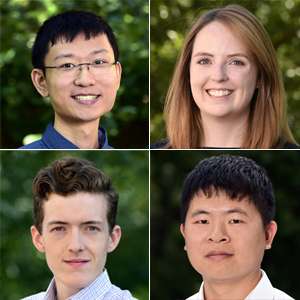An NIEHS-led research collaboration has received the National Institutes of Health (NIH) Director's Challenge Innovation Award.
 Coble directs the NIEHS vivarium, where he helps ensure researchers working with research animals receive the support they need and that the facility provides outstanding animal care and scientific support. (Photo courtesy of Steve McCaw / NIEHS)
Coble directs the NIEHS vivarium, where he helps ensure researchers working with research animals receive the support they need and that the facility provides outstanding animal care and scientific support. (Photo courtesy of Steve McCaw / NIEHS)Led by Dondrae Coble, D.V.M., chief of the Comparative Medicine Branch, the grant will fund the construction of multiple animal enclosures designed to help researchers observe the effects of 115 environmental chemicals on behavior. The enclosures help ensure that observations are minimally disruptive to the research animals, which include fruit flies and mice. Additionally, the researchers will use the grant to build a system to collect, analyze, store, and share data collected during the experimentation process.
The ultimate goal is to narrow down from 115 to 10 environmental chemicals that are most likely to cause potential neurodevelopmental disorders in fruit flies and mice, which can then be translated into the potential of those chemicals causing neurodevelopmental disorders in human children.
The effort brings together collaborators from the NIEHS Division of Intramural Research (DIR) and Division of the National Toxicology Program (DNTP), as well as at the National Institute of Diabetes and Digestive and Kidney Diseases and the National Institute of Biomedical Imaging and Bioengineering.
“The proposed project led by Dr. Coble, a recent NIEHS recruit from Nationwide Children’s Hospital and the Ohio State University, is highly meritorious and is precisely the type of innovative, high risk/high reward research that the NIH intramural program was designed to support,” said Darryl Zeldin, M.D., DIR scientific director. “I am thrilled that he and his outstanding research team received this highly competitive award.”
The award comes on the heels of previous NIEHS research also using holistic systems physiology initiated by Brian Berridge, D.V.M., Ph.D., DNTP scientific director — a method of doing animal modeling that measures the effects of environmental factors of multiple systems simultaneously. The method reduces the number of research animals while increasing the amount of information collected.
“As a laboratory animal medicine veterinarian, I want to utilize animals in the most responsible and appropriate manner,” Coble said. “If there are opportunities to refine our techniques or reduce animal use, that’s something I’m interested in pursuing.”
Applying autonomous car research to health
Developing the 24-hour observation instrumentation for the animal enclosures taps an unlikely source: the machine vision capabilities pioneered by autonomous vehicle research. Machine vision is when artificial intelligence (AI) is applied to processing images and video in real time using deep neural networks, which are used to train the AI to pick out features and learn as it goes.
 Cushman said that the project’s approach can be used not only as a model for extrapolating impacts on humans, but also on other species, such as bees or aquatic invertebrates. (Photo courtesy of Steve McCaw / NIEHS)
Cushman said that the project’s approach can be used not only as a model for extrapolating impacts on humans, but also on other species, such as bees or aquatic invertebrates. (Photo courtesy of Steve McCaw / NIEHS)“There are many ways we’re tracking ourselves all the time – with smart watches, apps, and sensors in our clothing – and now we’re building that into animal models,” said Jesse Cushman, Ph.D., director of the neurobehavioral core laboratory.
Just as a self-driving car can tell the difference between a person and a stop sign, the machine vision used in the enclosures will be trained to tell the difference between behaviors that transcend species, such as grooming, eating, sleeping, and interacting with others, as well as tell the difference between species-specific behaviors like wing expansion in fruit flies and foraging in mice.
By observing how environmental chemicals affect the behavior of fruit flies and mice, the researchers can extrapolate those effects to how they might impact human development.
“Broadly, cross-species extrapolation is a foundation of what we do in science,” Cushman said. “Regulators put a lot of weight on these in vivo studies, but they’re very expensive and time consuming — which we’re trying to address with this approach. It’s critical to have in vivo data in the whole organism to understand the full impact the compounds have. Our goal is to create a high throughput, scalable, automated method to do behavioral research that is better for the animals. We see this as foundational technology to build in holistic perspectives.”
(Kelley Christensen is a contract writer for the NIEHS Office of Communications and Public Liaison.)









